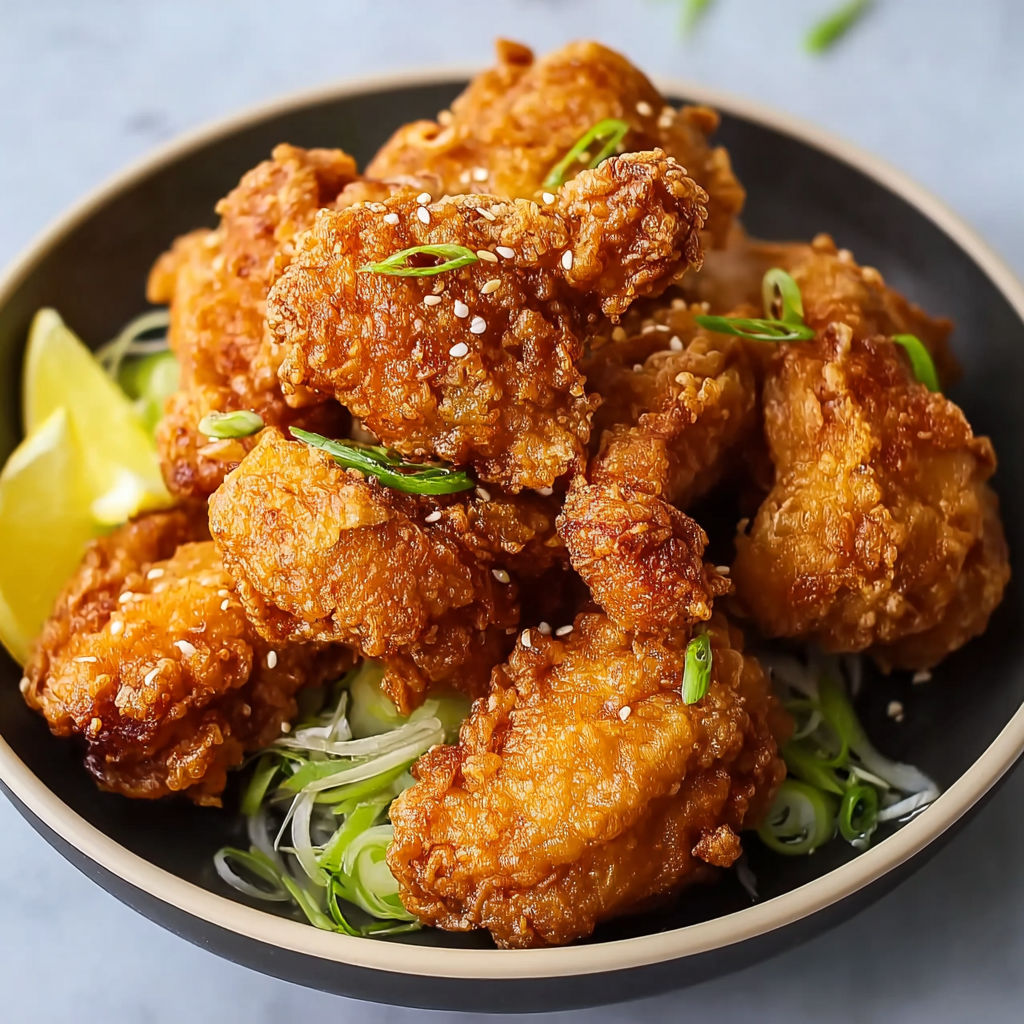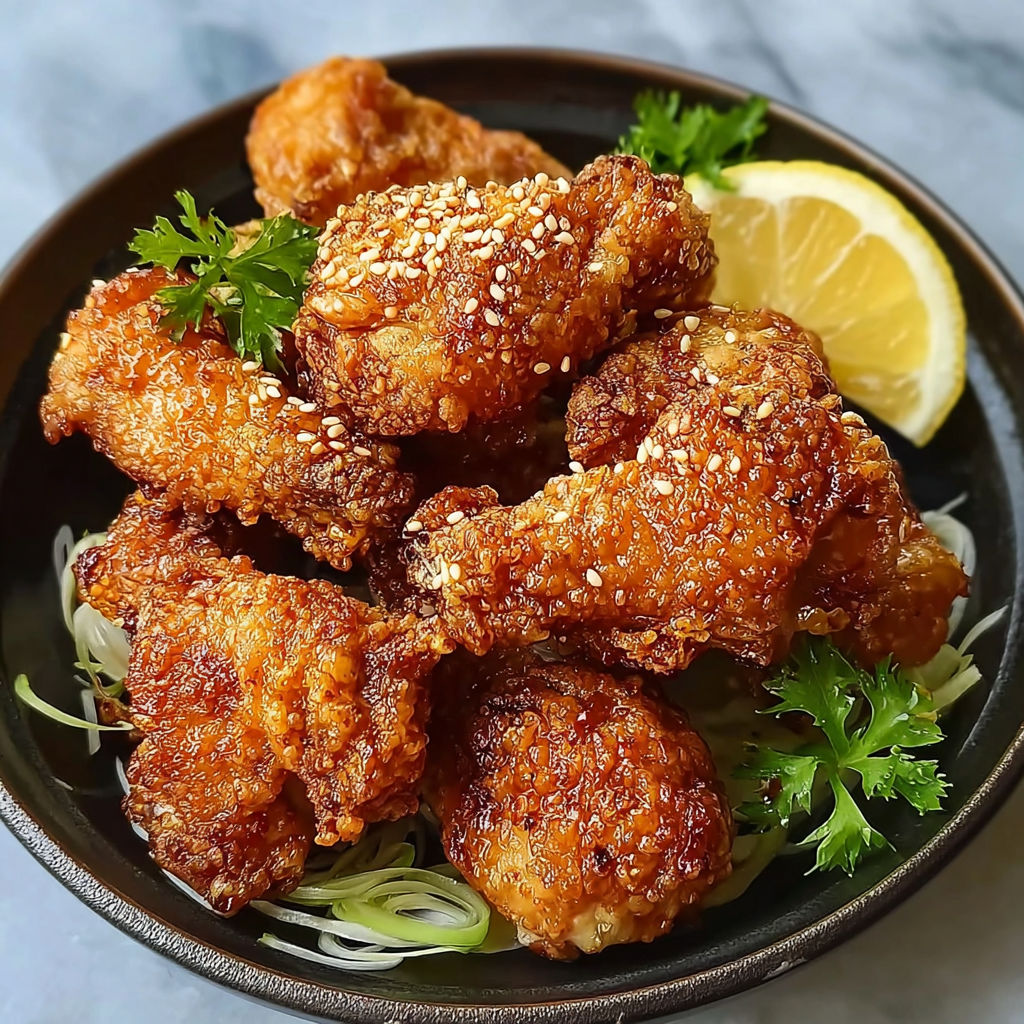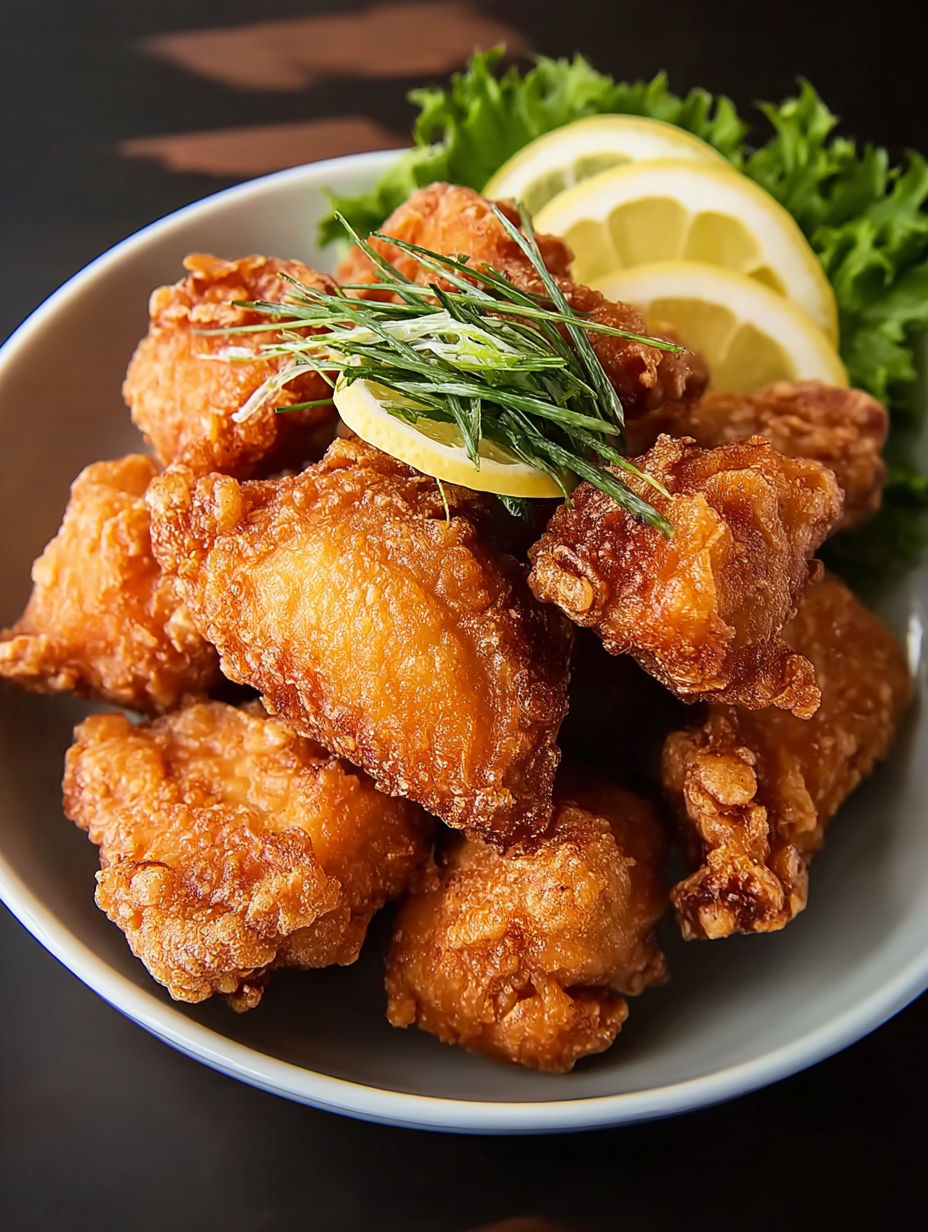 Pin
Pin
This Japanese fried chicken has changed my weeknight dinner game forever. Crispy on the outside with juicy tender meat inside, karaage brings authentic Japanese izakaya flavors right to your home kitchen with minimal effort.
I first made this karaage for my skeptical mother-in-law who claims to dislike fried foods. She ended up asking for the recipe before dinner was even over and now makes it for her bridge club regularly.
- Chicken thighs boneless and skinless. Dark meat is essential here as it stays juicy during frying and provides richer flavor than breast meat
- Soy sauce creates the umami foundation that makes karaage so addictive
- Sake Japanese rice wine tenderizes the meat and adds subtle complexity
- Grated ginger fresh is absolutely necessary as it infuses the chicken with warming aromatic notes
- Garlic minced provides depth and savory notes that complement the ginger beautifully
- Sesame oil just a touch rounds out the marinade with nutty undertones
- Potato starch the secret to that signature crispy coating that stays crunchy longer than regular flour
- All purpose flour mixed with potato starch creates the perfect texture balance
- Vegetable oil neutral flavored oil with high smoke point ensures clean frying
- Lemon wedges the bright acidity cuts through the richness perfectly
- Japanese mayo optional but highly recommended for that authentic experience
How To Make Japanese Fried Chicken (Karaage)
- Prepare the marinade
- Combine soy sauce, sake, freshly grated ginger, minced garlic, and sesame oil in a medium bowl. Whisk thoroughly until everything is well incorporated. This aromatic mixture is the foundation of karaage's distinctive flavor profile.
- Marinate the chicken
- Cut chicken thighs into 2 inch bite sized pieces and add them to the marinade. Use your hands to massage the marinade into each piece ensuring complete coverage. Cover the bowl with plastic wrap and refrigerate for at least 30 minutes but ideally 2 hours for maximum flavor penetration.
- Prepare the coating
- While the chicken marinates, mix potato starch and all purpose flour in a shallow dish. The combination creates the perfect balance between crispiness and adherence to the chicken. Some restaurants in Japan use only potato starch, but I find this combination more foolproof for home cooks.
- Heat the oil
- Pour vegetable oil into a heavy bottomed pot or deep pan until it reaches about 2 inches in depth. Heat to exactly 170°C. Too hot and the outside will burn before the inside cooks. Too cool and the chicken will absorb too much oil and become greasy.
- First fry
- Working in small batches of 5 to 6 pieces, remove chicken from marinade letting excess drip off. Coat each piece thoroughly in the flour mixture pressing gently to adhere. Carefully lower into hot oil and fry for about 90 seconds until light golden. Remove to a wire rack. This initial fry cooks the chicken through.
- Rest period
- Allow the first batch to rest for 4 minutes. This resting period is crucial as it allows the moisture inside to redistribute, creating steam that helps separate the coating from the meat slightly which results in an airier crunch.
- Second fry
- Return the chicken to the oil now at 180°C for just 1 to 2 minutes until deeply golden and irresistibly crispy. This double frying technique is what distinguishes truly exceptional karaage. The outside develops that characteristic crackly crust while the inside remains succulent.
- Serve immediately
- Transfer to a paper towel lined plate to absorb excess oil, then arrange on a serving platter with lemon wedges. Serve with Japanese mayo or a dipping sauce of your choice while still hot and at peak crispiness.
The ginger in this recipe is absolutely transformative. I once accidentally doubled the amount called for and discovered it created an even more aromatic result that my family now prefers. My daughter actually requested this karaage for her birthday dinner instead of going out to her favorite restaurant last year.

The Secret To Perfect Marination
The magic of karaage begins with proper marination. While 30 minutes will work in a pinch, allowing the chicken to marinate overnight transforms this dish completely. The acids in the sake begin breaking down proteins while the soy sauce penetrates deeper into the meat. For a family gathering, I prep the marinated chicken the night before and find the flavor development absolutely worth the planning ahead.
Make It A Meal
Karaage shines as part of a Japanese home style feast. Serve it alongside steamed short grain rice, miso soup, and a simple cucumber salad dressed with rice vinegar and sesame seeds. For an izakaya style experience at home, pair with cold beer or chilled sake and add edamame and pickled vegetables as side dishes. My family enjoys building rice bowls with karaage on top with thinly sliced green onions and a drizzle of spicy mayo.
Storing And Reheating
While karaage is best enjoyed fresh from the fryer, leftovers can be stored in an airtight container in the refrigerator for up to 3 days. To reheat, avoid the microwave which will make the coating soggy. Instead, place in a 350°F oven for 7 to 10 minutes until heated through and crispy again. For meal prep, you can marinate and coat the chicken then freeze raw on a baking sheet before transferring to freezer bags. Cook frozen pieces directly in oil adding about 2 minutes to the cooking time.
Regional Variations
Traditional karaage varies throughout Japan. In Oita Prefecture, karaage is often marinated with garlic and served with dashi soy sauce. Nakatsu style features larger chunks of chicken while Tatsuno style incorporates local citrus. My version pulls from classic Tokyo style karaage with the addition of sesame oil which I discovered during a cooking class in Kyoto. The instructor explained that each family has their own special twist on this beloved dish.

Recipe FAQs
- → What's the difference between Karaage and regular fried chicken?
Karaage differs from Western fried chicken in several ways. It typically uses boneless chicken thighs rather than bone-in pieces, marinates in soy sauce, sake, and ginger rather than buttermilk, and uses potato starch instead of breadcrumbs for coating. The result is a lighter, crispier exterior with distinctive umami flavor.
- → Can I use chicken breast instead of thighs for Karaage?
Yes, you can use chicken breast, though thighs are traditional because they remain juicier after frying. If using breast meat, cut into slightly larger pieces and reduce the frying time by about 30 seconds to prevent drying out. Consider marinating a bit longer to enhance tenderness.
- → What can I substitute for sake in the marinade?
If sake isn't available, dry sherry or Chinese rice wine (Shaoxing) work well as substitutes. For non-alcoholic options, use chicken broth with a teaspoon of rice vinegar or simply apple juice with a splash of vinegar to provide similar acidity and flavor depth.
- → How do I get the crispiest Karaage possible?
For maximum crispiness, double-fry your chicken. First, fry at a lower temperature (320°F/160°C) for 90 seconds to cook the chicken through. Rest for 1-2 minutes, then fry again at a higher temperature (350°F/175°C) until golden brown. Also, ensure your potato starch coating is thin and even, and never overcrowd your frying pan.
- → What are traditional sides to serve with Karaage?
Karaage is commonly served with shredded cabbage, steamed rice, miso soup, and Japanese pickles (tsukemono). For condiments, lemon wedges and Japanese mayonnaise (Kewpie) are traditional. It also pairs well with cold beer or sake for a complete izakaya-style meal experience.
- → How long does the chicken need to marinate?
For best results, marinate the chicken for at least 30 minutes and up to 4 hours. Marinating overnight is possible but not recommended as the acid in the marinade can start to break down the protein too much, affecting the texture. A 2-hour marinade generally provides optimal flavor without texture issues.
